formerly eScholarship Editions


|
|
|
|
Your request for similar items found 20 book(s). | Modify Search | Displaying 1 - 20 of 20 book(s) | |
| 1. | 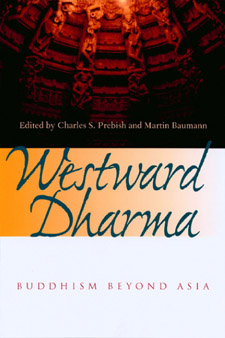 | Title: Westward dharma: Buddhism beyond Asia Author: Prebish, Charles S Published: University of California Press, 2002 Subjects: Religion | Asian Studies | Buddhism Publisher's Description: The first authoritative volume on the totality of Buddhism in the West, Westward Dharma establishes a comparative and theoretical perspective for considering the amazing variety of Buddhist traditions, schools, centers, and teachers that have developed outside of Asia. Leading scholars from North America, Europe, South Africa, and Australia explore the plurality and heterogeneity of traditions and practices that are characteristic of Buddhism in the West. This recent, dramatic growth in Western Buddhism is accompanied by an expansion of topics and issues of Buddhist concern. The contributors to this volume treat such topics as the broadening spirit of egalitarianism; the increasing emphasis on the psychological, as opposed to the purely religious, nature of practice; scandals within Buddhist movements; the erosion of the distinction between professional and lay Buddhists; Buddhist settlement in Israel; the history of Buddhism in internment camps; repackaging Zen for the West; and women's dharma in the West. The interconnections of historical and theoretical approaches in the volume make it a rich, multi-layered resource. [brief] Similar Items |
| 2. | 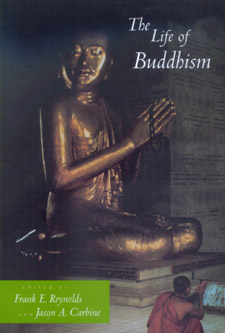 | Title: The life of Buddhism Author: Reynolds, Frank 1930- Published: University of California Press, 2000 Subjects: Religion | Asian Studies | Buddhism Publisher's Description: Bringing together fifteen essays by outstanding Buddhist scholars from Asia, Europe, and North America, this book offers a distinctive portrayal of the "life of Buddhism." The contributors focus on a number of religious practices across the Buddhist world, from Sri Lanka to New York, Japan to Tibet. The essays highlight not so much Buddhist doctrine or sacred texts, but rather the actual behavior and lived experience of Buddhist adherents. A general introduction by Frank E. Reynolds and Jason A. Carbine provides a historical overview and briefly characterizes the three major variants of Buddhist tradition - the Hinayana/Theravada branch practiced in Sri Lanka and much of Southeast Asia; the Mahayana branch located most notably in East Asia; and the Vajrayana/Esoteric branch established in Tibet and Japan. It also takes note of a distinctive form of Buddhism that is now emerging among non-Asian practitioners in the West. The editors introduce each essay with a brief commentary that situates its contents within the Buddhist tradition as a whole. The pieces offer concise depictions and analyses of particular aspects of Buddhist life, including temple architecture and iconography, the consecration of sacred objects, meditative practices, devotional expressions, exorcisms, and pilgrimage journeys. Topics discussed also include the construction of religio-political and religio-social hierarchies, gender roles, the management of asocial behavior, and confrontations with dying and death. [brief] Similar Items |
| 3. | 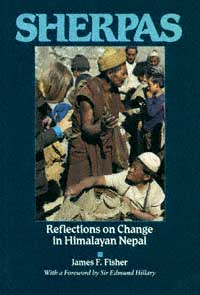 | Title: Sherpas: reflections on change in Himalayan Nepal Author: Fisher, James F Published: University of California Press, 1990 Subjects: Anthropology | Cultural Anthropology | South Asia Publisher's Description: James Fisher combines the strengths of technical anthropology, literary memoir, and striking photography in this telling study of rapid social change in Himalayan Nepal. The author first visited the Sherpas of Nepal when he accompanied Sir Edmund Hilary on the Himalayan Schoolhouse Expedition of 1964. Returning to the Everest region several times during the 1970s and 1980s, he discovered that the construction of the schools had far less impact than one of the by-products of their building: a short-take-off-and-landing airstrip. By reducing the time it took to travel between Kathmandu and the Everest region from a hike of several days to a 45-minute flight, the airstrip made a rapid increase in tourism possible. Beginning with his impressions of Sherpa society in pre-tourist days, Fisher traces the trajectory of contemporary Sherpa society reeling under the impact of modern education and mass tourism, and assesses the Sherpa's concerns for their future and how they believe these problems should be and eventually will be resolved. [brief] Similar Items |
| 4. | 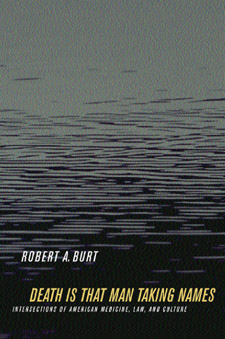 | Title: Death is that man taking names: intersections of American medicine, law, and culture Author: Burt, Robert 1939- Published: University of California Press, 2002 Subjects: Law | Health Care | History of Medicine | Ethics | Religion Publisher's Description: The American culture of death changed radically in the 1970s. For terminal illnesses, hidden decisions by physicians were rejected in favor of rational self-control by patients asserting their "right to die" - initially by refusing medical treatment and more recently by physician-assisted suicide. This new claim rested on two seemingly irrefutable propositions: first, that death can be a positive good for individuals whose suffering has become intolerable; and second, that death is an inevitable and therefore morally neutral biological event. Death Is That Man Taking Names suggests, however, that a contrary attitude persists in our culture - that death is inherently evil, not just in practical but also in moral terms. The new ethos of rational self-control cannot refute but can only unsuccessfully try to suppress this contrary attitude. The inevitable failure of this suppressive effort provokes ambivalence and clouds rational judgment in many people's minds and paradoxically leads to inflictions of terrible suffering on terminally ill people. Judicial reforms in the 1970s of abortion and capital punishment were driven by similarly high valuations of rationality and public decision-making - rejecting physician control over abortion in favor of individual self-control by pregnant women and subjecting unsupervised jury decisions for capital punishment to supposed rationally guided supervision by judges. These reforms also attempt to suppress persistently ambivalent attitudes toward death, and are therefore prone to inflicting unjustified suffering on pregnant women and death-sentenced prisoners. In this profound and subtle account of psychological and social forces underlying American cultural attitudes toward death, Robert A. Burt maintains that unacknowledged ambivalence is likely to undermine the beneficent goals of post-1970s reforms and harm the very people these changes were intended to help. [brief] Similar Items |
| 5. | 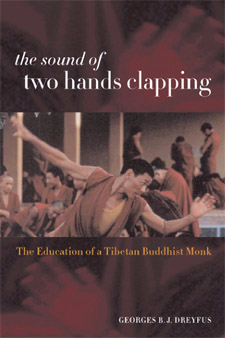 | Title: The sound of two hands clapping: the education of a Tibetan Buddhist monk Author: Dreyfus, Georges B. J Published: University of California Press, 2003 Subjects: Religion | Buddhism | Tibet | Autobiographies and Biographies | Buddhism Publisher's Description: A unique insider's account of day-to-day life inside a Tibetan monastery, The Sound of Two Hands Clapping reveals to Western audiences the fascinating details of monastic education. Georges B. J. Dreyfus, the first Westerner to complete the famous Ge-luk curriculum and achieve the distinguished titl . . . [more] Similar Items |
| 6. | 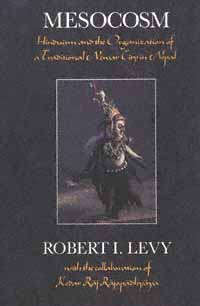 | Title: Mesocosm: Hinduism and the organization of a traditional Newar city in Nepal Author: Levy, Robert I. (Robert Isaac) 1924- Published: University of California Press, 1991 Subjects: Anthropology | Tibet | Hinduism | Asian History Publisher's Description: Mesocosm is a study of Hinduism in its most fully realized form as a symbolic system for organizing the life of a particular kind of city - what the author terms an "archaic" city. The work is a detailed description and analysis of the symbolic world of Bhaktapur, a unicultural city in the Kathmandu Valley, a city which is perhaps the last surviving example of a type of organization once widespread in the ancient world.Robert Levy views Bhaktapur as a structured "mesocosm," mediating between the microcosm of individual self-conception and the macrocosm of the culturally conceived larger universe. The city is a bounded entity, grounded on a minutely divided and interrelated sacrilized space. It uses that space, roles assigned by an elaborate caste system, a semantically differentiated pantheon, and the tempos and forms of the festival year and rites of passage to construct a "civic dance," a web of communication and instruction which deeply affects the experience of Bhaktapur's citizens. Levy investigates the meaning of the community to the people who live there and suggests how the religious forms that have challenged Hinduism in South Asia - Christianity and, above all, Islam - are profoundly antithetical to Hinduism as the organizing principle for cities such as Bhaktapur. Mesocosm is a groundbreaking contribution to anthropology, social and religious history, and Indian and Nepalese studies. [brief] Similar Items |
| 7. | 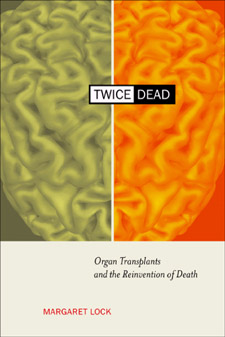 | Title: Twice dead: organ transplants and the reinvention of death Author: Lock, Margaret M Published: University of California Press, 2001 Subjects: Anthropology | Medical Anthropology | Cultural Anthropology | Ethics | Sociology | Sociology | Ethics | Sociology | Ethnic Studies | Ethnic Studies Publisher's Description: Tales about organ transplants appear in mythology and folk stories, and surface in documents from medieval times, but only during the past twenty years has medical knowledge and technology been sufficiently advanced for surgeons to perform thousands of transplants each year. In the majority of cases individuals diagnosed as "brain dead" are the source of the organs without which transplants could not take place. In this compelling and provocative examination, Margaret Lock traces the discourse over the past thirty years that contributed to the locating of a new criterion of death in the brain, and its routinization in clinical practice in North America. She compares this situation with that in Japan where, despite the availability of the necessary technology and expertise, brain death was legally recognized only in 1997, and then under limited and contested circumstances. Twice Dead explores the cultural, historical, political, and clinical reasons for the ready acceptance of the new criterion of death in North America and its rejection, until recently, in Japan, with the result that organ transplantation has been severely restricted in that country. This incisive and timely discussion demonstrates that death is not self-evident, that the space between life and death is historically and culturally constructed, fluid, multiple, and open to dispute. In addition to an analysis of that professional literature on and popular representations of the subject, Lock draws on extensive interviews conducted over ten years with physicians working in intensive care units, transplant surgeons, organ recipients, donor families, members of the general public in both Japan and North America, and political activists in Japan opposed to the recognition of brain death. By showing that death can never be understood merely as a biological event, and that cultural, medical, legal, and political dimensions are inevitably implicated in the invention of brain death, Twice Dead confronts one of the most troubling questions of our era. [brief] Similar Items |
| 8. | 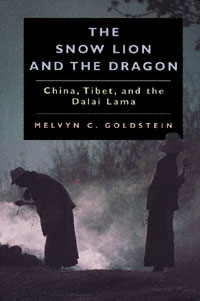 | Title: The snow lion and the dragon: China, Tibet, and the Dalai Lama Author: Goldstein, Melvyn C Published: University of California Press, 1997 Subjects: History | Politics | Asian History | China | Cultural Anthropology | Tibet Publisher's Description: Tensions over the "Tibet Question" - the political status of Tibet - are escalating every day. The Dalai Lama has gained broad international sympathy in his appeals for autonomy from China, yet the Chinese government maintains a hard-line position against it. What is the history of the conflict? Can the two sides come to an acceptable compromise? In this thoughtful analysis, distinguished professor and longtime Tibet analyst Melvyn C. Goldstein presents a balanced and accessible view of the conflict and a proposal for the future.Tibet's political fortunes have undergone numerous vicissitudes since the fifth Dalai Lama first ascended to political power in Tibet in 1642. In this century, a forty-year period of de facto independence following the fall of the Qing dynasty in 1911 ended abruptly when the Chinese Communists forcibly incorporated Tibet into their new state and began the series of changes that destroyed much of Tibet's traditional social, cultural, and economic system. After the death of Mao in 1976, the rise to power of Deng Xiaoping quickly produced a change in attitude in Beijing and a major initiative to negotiate with the Dalai Lama to solve the conflict. This failed. With the death of Deng Xiaoping, the future of Tibet is more uncertain than ever, and Goldstein argues that the conflict could easily erupt into violence.Drawing upon his deep knowledge of the Tibetan culture and people, Goldstein takes us through the history of Tibet, concentrating on the political and cultural negotiations over the status of Tibet from the turn of the century to the present. He describes the role of Tibet in Chinese politics, the feeble and conflicting responses of foreign governments, overtures and rebuffs on both sides, and the nationalistic emotions that are inextricably entwined in the political debate. Ultimately, he presents a plan for a reasoned compromise, identifying key aspects of the conflict and appealing to the United States to play an active diplomatic role. Clearly written and carefully argued, this book will become the definitive source for anyone seeking an understanding of the Tibet Question during this dangerous turning point in its turbulent history. [brief] Similar Items |
| 9. | 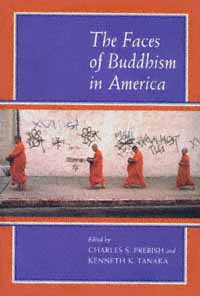 | Title: The faces of Buddhism in America Author: Prebish, Charles S Published: University of California Press, 1998 Subjects: Religion | Buddhism | American Studies | Gender Studies Publisher's Description: Buddhism is the fastest growing religion in the United States, with adherents estimated in the several millions. But what exactly defines a "Buddhist"? This has been a much-debated question in recent years, particularly in regard to the religion's bifurcation into two camps: the so-called "imported" or ethnic Buddhism of Asian immigrants and the "convert" Buddhism of a mostly middle-class, liberal, intellectual elite. In this timely collection Charles S. Prebish and Kenneth K. Tanaka bring together some of the leading voices in Buddhist studies to examine the debates surrounding contemporary Buddhism's many faces.The contributors investigate newly Americanized Asian traditions such as Tibetan, Zen, Nichiren, Jodo Shinshu, and Theravada Buddhism and the changes they undergo to meet the expectations of a Western culture desperate for spiritual guidance. Race, feminism, homosexuality, psychology, environmentalism, and notions of authority are some of the issues confronting Buddhism for the first time in its three-thousand-year history and are powerfully addressed here.In recent years American Buddhism has been featured as a major story on ABC television news, National Public Radio, and in other national media. A strong new Buddhist journalism is emerging in the United States, and American Buddhism has made its way onto the Internet. The faces of Buddhism in America are diverse, active, and growing, and this book will be a valuable resource for anyone interested in understanding this vital religious movement. [brief] Similar Items |
| 10. | 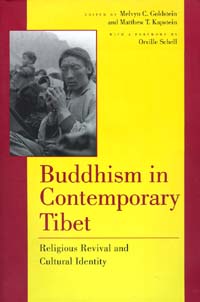 | Title: Buddhism in contemporary Tibet: religious revival and cultural identity Author: Goldstein, Melvyn C Published: University of California Press, 1998 Subjects: Religion | Cultural Anthropology | Tibet | Buddhism Publisher's Description: Following the upheavals of the Cultural Revolution, the People's Republic of China gradually permitted the renewal of religious activity. Tibetans, whose traditional religious and cultural institutions had been decimated during the preceding two decades, took advantage of the decisions of 1978 to begin a Buddhist renewal that is one of the most extensive and dramatic examples of religious revitalization in contemporary China. The nature of that revival is the focus of this book. Four leading specialists in Tibetan anthropology and religion conducted case studies in the Tibet autonomous region and among the Tibetans of Sichuan and Qinghai provinces. There they observed the revival of the Buddhist heritage in monastic communities and among laypersons at popular pilgrimages and festivals. Demonstrating how that revival must contend with tensions between the Chinese state and aspirations for greater Tibetan autonomy, the authors discuss ways that Tibetan Buddhists are restructuring their religion through a complex process of social, political, and economic adaptation. Buddhism has long been the main source of Tibetans' pride in their culture and country. These essays reveal the vibrancy of that ancient religion in contemporary Tibet and also the problems that religion and Tibetan culture in general are facing in a radically altered world. [brief] Similar Items |
| 11. | 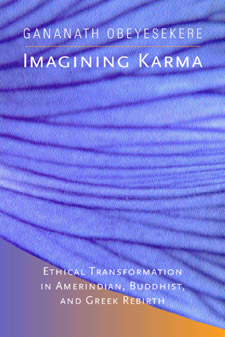 | Title: Imagining karma: ethical transformation in Amerindian, Buddhist, and Greek rebirth Author: Obeyesekere, Gananath Published: University of California Press, 2002 Subjects: Religion | Anthropology | Buddhism | Classics | Indigenous Religions | Asian Studies Publisher's Description: With Imagining Karma, Gananath Obeyesekere embarks on the very first comparison of rebirth concepts across a wide range of cultures. Exploring in rich detail the beliefs of small-scale societies of West Africa, Melanesia, traditional Siberia, Canada, and the northwest coast of North America, Obeyesekere compares their ideas with those of the ancient and modern Indic civilizations and with the Greek rebirth theories of Pythagoras, Empedocles, Pindar, and Plato. His groundbreaking and authoritative discussion decenters the popular notion that India was the origin and locus of ideas of rebirth. As Obeyesekere compares responses to the most fundamental questions of human existence, he challenges readers to reexamine accepted ideas about death, cosmology, morality, and eschatology. Obeyesekere's comprehensive inquiry shows that diverse societies have come through independent invention or borrowing to believe in reincarnation as an integral part of their larger cosmological systems. The author brings together into a coherent methodological framework the thought of such diverse thinkers as Weber, Wittgenstein, and Nietzsche. In a contemporary intellectual context that celebrates difference and cultural relativism, this book makes a case for disciplined comparison, a humane view of human nature, and a theoretical understanding of "family resemblances" and differences across great cultural divides. [brief] Similar Items |
| 12. | 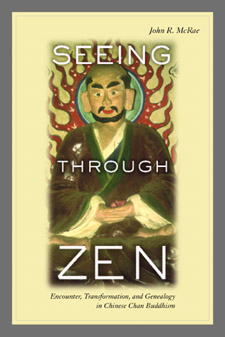 | Title: Seeing through Zen: encounter, transformation, and genealogy in Chinese Chan Buddhism Author: McRae, John R 1947- Published: University of California Press, 2004 Subjects: Religion | China | Buddhism Publisher's Description: The tradition of Chan Buddhism - more popularly known as Zen - has been romanticized throughout its history. In this book, John R. McRae shows how modern critical techniques, supported by recent manuscript discoveries, make possible a more skeptical, accurate, and - ultimately - productive assessment of Chan lineages, teaching, fundraising practices, and social organization. Synthesizing twenty years of scholarship, Seeing through Zen offers new, accessible analytic models for the interpretation of Chan spiritual practices and religious history. Writing in a lucid and engaging style, McRae traces the emergence of this Chinese spiritual tradition and its early figureheads, Bodhidharma and the "sixth patriarch" Huineng, through the development of Zen dialogue and koans. In addition to constructing a central narrative for the doctrinal and social evolution of the school, Seeing through Zen examines the religious dynamics behind Chan's use of iconoclastic stories and myths of patriarchal succession. McRae argues that Chinese Chan is fundamentally genealogical, both in its self-understanding as a school of Buddhism and in the very design of its practices of spiritual cultivation. Furthermore, by forgoing the standard idealization of Zen spontaneity, we can gain new insight into the religious vitality of the school as it came to dominate the Chinese religious scene, providing a model for all of East Asia - and the modern world. Ultimately, this book aims to change how we think about Chinese Chan by providing new ways of looking at the tradition. [brief] Similar Items |
| 13. | 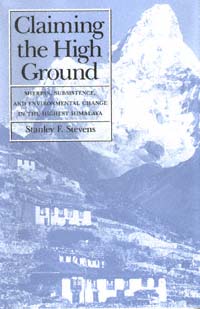 | Title: Claiming the high ground: Sherpas, subsistence, and environmental change in the highest Himalaya Author: Stevens, Stanley F Published: University of California Press, 1993 Subjects: Geography | Cultural Anthropology | Tibet Publisher's Description: Stanley Stevens brings a new historical perspective to his remarkably well-researched study of a subsistence society in ever-increasing contact with the outside world. The Khumbu Sherpas, famous for their mountaineering exploits, have frequently been depicted as victims of the world's highest-altitude tourist boom. But has the flow of outsiders to Mt. Everest and the heights of Nepal in fact destroyed a stable, finely balanced relationship between the Sherpas and their environment?Stevens's innovative use of oral history and cultural ecology suggests that tourism is not the watershed circumstance many have considered it to be. Drawing on extensive interviews and data gathered during three years of fieldwork, and with the use of numerous maps and charts, he documents the Sherpas' ingenious adaptation to high-altitude conditions, their past and present agricultural, pastoral, trade, and forest management practices, and their own perspectives on the environmental history of their homeland. This is a book for geographers, anthropologists, and all those interested in conservation of the earth's high places. [brief] Similar Items |
| 14. | 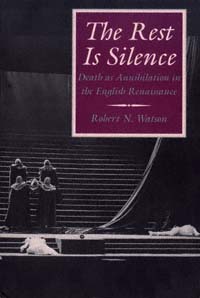 | Title: The rest is silence: death as annihilation in the English Renaissance Author: Watson, Robert N Published: University of California Press, 1995 Subjects: Literature | English Literature | Literary Theory and Criticism | Renaissance Literature Publisher's Description: How did the fear of death coexist with the promise of Christian afterlife in the culture and literature of the English Renaissance? Robert Watson exposes a sharp edge of blasphemous protest against mortality that runs through revenge plays such as The Spanish Tragedy and Hamlet , and through plays of procreation such as Measure for Measure and Macbeth . Tactics of denial appear in the vengefulness that John Donne directs toward female bodies for failing to bestow immortality, and in the promise of renewal that George Herbert sets against the threat of closure.Placing these literary manifestations in the context of specific Jacobean deathbed crises and modern cultural distortions, Watson explores the psychological roots and political consequences of denying that death permanently erases sensation and consciousness. [brief] Similar Items |
| 15. | 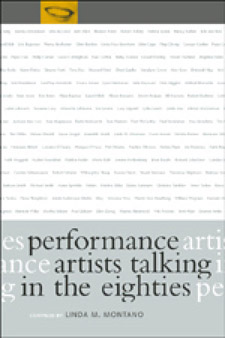 | Title: Performance artists talking in the eighties: sex, food, money/fame, ritual/death Author: Montano, Linda 1942- Published: University of California Press, 2001 Subjects: Art | Art History | Cinema and Performance Arts Publisher's Description: Performance artist Linda Montano, curious about the influence childhood experience has on adult work, invited other performance artists to consider how early events associated with sex, food, money/fame, or death/ritual resurfaced in their later work. The result is an original and compelling talking performance that documents the production of art in an important and often misunderstood community. Among the more than 100 artists Montano interviewed from 1979 to 1989 were John Cage, Suzanne Lacy, Faith Ringgold, Dick Higgins, Annie Sprinkle, Allan Kaprow, Meredith Monk, Eric Bogosian, Adrian Piper, Karen Finley, and Kim Jones. Her discussions with them focused on the relationship between art and life, history and memory, the individual and society, and the potential for individual and social change. The interviews highlight complex issues in performance art, including the role of identity in performer-audience relationships and art as an exploration of everyday conventions rather than a demonstration of virtuosity. [brief] Similar Items |
| 16. | 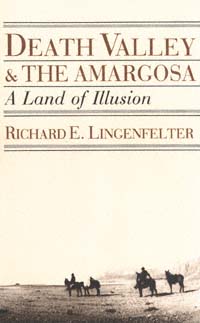 | Title: Death Valley & the Amargosa: a land of illusion Author: Lingenfelter, Richard E Published: University of California Press, 1988 Subjects: History | California and the West | United States History Similar Items |
| 17. | 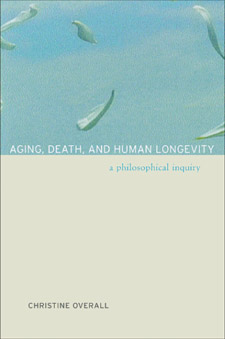 | Title: Aging, death, and human longevity: a philosophical inquiry Author: Overall, Christine 1949- Published: University of California Press, 2003 Subjects: Philosophy | Ethics | Public Policy Publisher's Description: With the help of medicine and technology we are living longer than ever before. As human life spans have increased, the moral and political issues surrounding longevity have become more complex. Should we desire to live as long as possible? What are the social ramifications of longer lives? How does a longer life span change the way we think about the value of our lives and about death and dying? Christine Overall offers a clear and intelligent discussion of the philosophical and cultural issues surrounding this difficult and often emotionally charged issue. Her book is unique in its comprehensive presentation and evaluation of the arguments - both ancient and contemporary - for and against prolonging life. It also proposes a progressive social policy for responding to dramatic increases in life expectancy. Writing from a feminist perspective, Overall highlights the ways that our biases about race, class, and gender have affected our views of elderly people and longevity, and her policy recommendations represent an effort to overcome these biases. She also covers the arguments surrounding the question of the "duty to die" and includes a provocative discussion of immortality. After judiciously weighing the benefits and the risks of prolonging human life, Overall persuasively concludes that the length of life does matter and that its duration can make a difference to the quality and value of our lives. Her book will be an essential guide as we consider our social responsibilities, the meaning of human life, and the prospects of living longer. [brief] Similar Items |
| 18. | 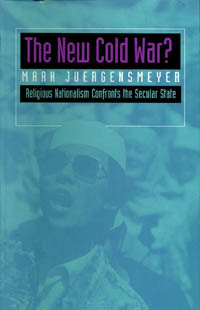 | Title: The new Cold War?: religious nationalism confronts the secular state Author: Juergensmeyer, Mark Published: University of California Press, 1993 Subjects: Politics | Asian Studies | Religion | Social Problems | Middle Eastern Studies | South Asia Publisher's Description: Will the religious confrontations with secular authorities around the world lead to a new Cold War? Mark Juergensmeyer paints a provocative picture of the new religious revolutionaries altering the political landscape in the Middle East, South Asia, Central Asia, and Eastern Europe. Impassioned Muslim leaders in Egypt, Palestine, and Algeria, political rabbis in Israel, militant Sikhs in India, and triumphant Catholic clergy in Eastern Europe are all players in Juergensmeyer's study of the explosive growth of religious movements that decisively reject Western ideas of secular nationalism.Juergensmeyer revises our notions of religious revolutions. Instead of viewing religious nationalists as wild-eyed, anti-American fanatics, he reveals them as modern activists pursuing a legitimate form of politics. He explores the positive role religion can play in the political life of modern nations, even while acknowledging some religious nationalists' proclivity to violence and disregard of Western notions of human rights. Finally, he situates the growth of religious nationalism in the context of the political malaise of the modern West. Noting that the synthesis of traditional religion and secular nationalism yields a religious version of the modern nation-state, Juergensmeyer claims that such a political entity could conceivably embrace democratic values and human rights. [brief] Similar Items |
| 19. | 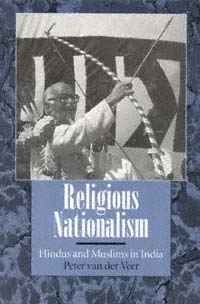 | Title: Religious nationalism: Hindus and Muslims in India Author: Veer, Peter van der Published: University of California Press, 1994 Subjects: Anthropology | Cultural Anthropology | Hinduism | South Asia Publisher's Description: Religious nationalism is a subject of critical importance in much of the world today. Peter van der Veer's timely study on the relationship between religion and politics in India goes well beyond other books on this subject. He brings together several disciplines - anthropology, history, social theory, literary studies - to show how Indian religious identities have been shaped by pilgrimage, migration, language development, and more recently, print and visual media.Van der Veer's central focus is the lengthy dispute over the Babari mosque in Ayodhya, site of a bloody confrontation between Hindus and Muslims in December 1992. A thought-provoking range of other examples describes the historical construction of religious identities: cow protection societies and Sufi tombs, purdah and the political appropriation of images of the female body, Salman Rushdie and the role of the novel in nationalism, Mahatma Gandhi and Swami Vivekananda, the Khalsa movement among Sikhs, and nationalist archaeology and the televised Ramayana .Van der Veer offers a new perspective on the importance of religious organization and the role of ritual in the formation of nationalism. His work advances our understanding of contemporary India while also offering significant theoretical insights into one of the most troubling issues of this century. [brief] Similar Items |
| 20. | 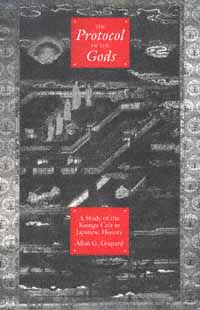 | Title: The protocol of the gods: a study of the Kasuga cult in Japanese history Author: Grapard, Allan G Published: University of California Press, 1993 Subjects: Religion | Asian History | Japan Publisher's Description: The Protocol of the Gods is a pioneering study of the history of relations between Japanese native institutions (Shinto shrines) and imported Buddhist institutions (Buddhist temples). Using the Kasuga Shinto shrine and the Kofukuji Buddhist temple, one of the oldest and largest of the shrine-temple complexes, Allan Grapard characterizes what he calls the combinatory character of pre-modern Japanese religiosity. He argues that Shintoism and Buddhism should not be studied in isolation, as hitherto supposed. Rather, a study of the individual and shared characteristics of their respective origins, evolutions, structures, and practices can serve as a model for understanding the pre-modern Japanese religious experience.Spanning the years from a period before historical records to the forcible separation of the Kasuga-Kofukuji complex by the Meiji government in 1868, Grapard presents a wealth of little-known material. He includes translations of rare texts and provides new, accessible translations of familiar documents. [brief] Similar Items |